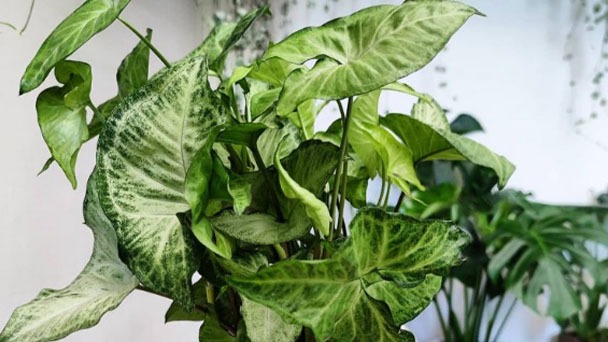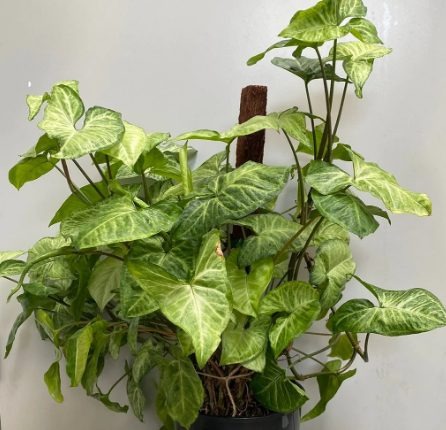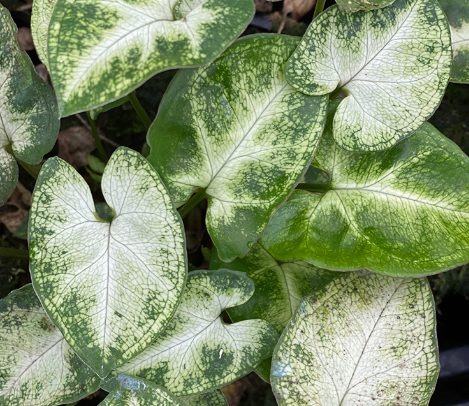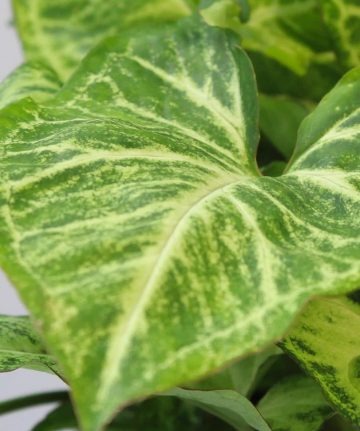Syngonium White Butterfly Care - Your Ulitimate Guide 2023
Written by Ivy
Jan 09 2023

Syngonium White Butterfly are low-maintenance houseplants that thrive in bright indirect light and will flourish in your indoor garden given the right conditions. Here is a White Butterfly Syngonium care guide that includes watering recommendations and propagation pointers.
What is a White Butterfly Syngonium?

A beautiful indoor plant, white butterfly syngonium is distinguished by its creamy white foliage. The plant is native to South American countries and is also popularly called the arrowhead plant or the butterfly plant. For hanging baskets on patios and driveways, its long cascading appearance makes it perfect.
Syngonium White Butterfly Care
Water
Better soil conditions for the Syngonium White Butterfly's growth. Watering should be done in a way that permits the soil to dry. The "little and often" watering strategy used by most gardeners is ineffective for the Syngonium White Butterfly plant. Plant water requirements should be assessed by growers, who should then adjust them as the seasons change. For instance, to account for the slow drying process during the winter, the time between waterings is increased.
Light and Humidity
Syngonium White Butterfly needs humidity; dry air results in brown leaf crisping. It is essential to maintain humidity levels above 60%. To increase humidity, simple techniques can be used, including grouping plants, misting, pebble trays, and humidifiers. Put your plant in a spot where it will receive lots of indirect light. The leaves become scorched after prolonged exposure to the sun. The plant does well in a range of 61 and 70 degrees Fahrenheit. It is essential to keep the room's temperature above 55°F.
Soil and Fertilizer
The Syngonium White Butterfly thrives in well-drained soils that are rich in organic matter and shaded by trees in its natural habitat. Use half ocean forest, quarter coco coir, and quarter charcoal and pumice soil to make a potting mix to mimic similar soil conditions. By adding three or four handfuls of worm compost, you can flavor the mixture. Additionally effective is general-purpose potting soil.
At least once per month, use liquid fertilizer for indoor plants at half its recommended strength. Alternately, use slow-release fertilizer, or top-dress in the early spring with compost or worm castings.
Pruning
Use modern cleaning techniques to clean your plant, such as dusting and wiping with a soft, damp cloth. Pruning is necessary to maintain the plant's structure and prevent the unsightly flop effect. Since they are poisonous if consumed, keep them out of reach of pets and young children. To prune, remove undesirable leaves and overgrown stems with a sharp knife or pair of scissors. Take precautions to keep your eyes away from the plant's milky byproduct.
Repotting
As opposed to the roots, the Syngonium White Butterfly's growth occurs mostly around the stems and leaves. Because of this, plants typically look best in small pots. Repotting the plant into a larger pot is honorable if you observe slowed growth or an increase in watering frequency. Repotting entails uprooting the plant, covering the drainage holes in the new pot with a coffee filter, and adding a layer of potting soil. Plant it in the new container, loosen the roots, and give it enough water. Take the plant to its designated location, allowing the soil to drain.
White Butterfly Arrowhead Plant Propagation
By germination of its cuttings in a soil or water medium, the Syngonium White Butterfly can be easily multiplied. Cut a new growth shoot with one or two leaves a few inches below the first pair of nodes. Submerge the cutting and keep the water level up. The plant should be moved to a pot after a few weeks, once the root system has developed. If you decide to plant the cutting directly into the soil, it is best to first soak it in a hormone that promotes rooting.
Ideal Season to Propagate
The right season to propagate is during the warm months of spring and summer. These are the months for growth when the temperature will be just right for the plant to grow strong roots.
Moreover, the growth rate will be faster in these months in comparison to the cooler months of fall and the chilly winter months when the plant will enter a state of dormancy.
Tools Required
Before you start the process, have the following tools available and ready. Your job will become easier as a result.
- In order to stop the spread of bacterial infections, sterilize a sharp garden pruner or propagation knife with an alcohol solution before making any cuts.
- A light potting soil to place the plant in
- A container, pot or shallow tray with well-draining drainage holes
- A plastic sheet or wrap with tiny holes or a glass container with breathable openings
- Rooting hormone powder
Propagation Method
The white butterfly syngonium can be propagated through stem cuttings in water or soil and division. Be aware that the plant is quite uncommon because it grows and reproduces more slowly and prefers the South American regions where it was originally discovered. As a result, wait patiently for the results.
Propagation through Stem Cuttings
To grow new offsets, use stem cuttings. You can let the cuttings root in water or directly in the soil, though rooting is faster in water in comparison to soil. Additionally, you will need to change the water once a week if rooting in water to restore the oxygen supply to the stem section.
Find the detailed procedure listed below:
- A mature mother plant's stem should be gently cut, and you should ensure that the section has at least one node.
- Rooting hormone powder should be applied to the section's cut end.
- Put this cutting in water or right into the ground to allow it to root. If you are living in a dry zone, you can choose to keep it covered with a case or plastic sheet with holes for ventilation to create some humidity around the stem. This will greatly speed up the process as a whole.
- The cut portion of the plant will start to form its first baby roots in a few weeks.
- Transplant it into potting soil when you spot the roots developing more prominently and when fresh foliage begins to grow. For the plant to begin to grow leaves and a more robust stem, it will need a few more weeks.
- As the plant thrives even when it is root-bound, your white butterfly syngonium plant won't need to be repotted frequently. However, you can consider repotting them once every two years to replenish the soil with peat or compost nutrients and tackle issues such as root rot.
Propagation through Division
The division method entails taking the plant completely out of the ground and dividing it from the root system. Here are the details of the process:
- Choose a mature, healthy plant, and take it, along with the soil, out of the pot gently. The plant will completely slip out of the container with a light tap on the base. Loosen the excess soil at the roots to make the sections visible.
- Snip a piece of the plant, leaving the stem, leaves, and part of the roots intact, using a pair of sterile garden shears or a sharp knife.
- Repot the original plant. This is the time when you can inspect for root rot or fungal diseases at the roots and gently snip them away.
- In fresh potting soil, plant the cut section, and take normal care of it. You may notice the mother plant as well as the freshly potted section showing signs of wilting, but this is normal and is due to transplantation stress.
- Both plants will be ready to go in a few days.
White Butterfly Plant Size & Growth
The white butterfly Syngonium, if given the opportunity to grow, can end up being 3 to 6 feet long and 1 to 2 feet wide.
If the plant has a support or is grown as a hanging plant, it will grow longer and in a different direction.
White butterfly plants that lack gravity or support grow more tightly and tangledly.
The leaves of Syngonium white butterfly develop with age, giving the plant a distinctive and varied appearance.
The edges of new leaves are typically dark green, with a silvery-white to cream core.
Syngonium leaves develop into the recognizable butterfly arrowhead shape as they get older. This is until the leaves take on a final lobed appearance and length of 5″ to 14" inches long.
Over time, color and pattern change. The majority of the leaves range in color from greenish-white to white, creamy white, or silvery white.

White Butterfly Arrowheads Plants Flowering and Fragrance
Syngonium white butterfly rarely produces flowers when grown indoors. A mature white butterfly arrowhead plant blooms as small, greenish-white flowers on a thick spadex. Red or brown-black berries eventually replace them.
White Butterfly Syngonium Pests Or Diseases
Viruses and pests have a hard time destroying healthy plants. A sick plant may suffer many problems, including:
- Aphids
- Bacterial leaf spot
- Mealybugs
- Root rot
- Scale
- Spider mites
Florida views this plant as invasive.
Due to its high calcium oxalate content, it is also only mildly toxic.
If ingested, this may cause:
- Difficulty swallowing
- Drooling
- Gastric distress
- Kidney stones
- Swelling
- Vomiting
The effects are more pronounced in horses than in cats, dogs, or people.
Itching skin could be brought on by the sap. When working with the plant, gloves are usually advised.
Suggested Syngonium White Butterfly Uses
A hanging basket is the ideal environment for the White Butterfly Syngonium. Despite thriving best in a kitchen or bathroom, the Syngonium White Butterfly will add brightness to any room in your house.
The white butterfly plant's ability to thrive in artificial light enables its white and green leaves to liven up an office.
Common Problems With Syngonium White Butterfly
Why Are the Leaves Turning Yellow?
This could be the case for a few reasons. First and foremost, the plant's leaves will turn yellow if it does not receive enough water.
The same will nevertheless occur if the plant is overwatered as well! Make sure the plant is being watered according to your schedule, and check your irrigation system.
If that's not the issue, the Syngonium might be lacking in nitrogen. To see if it resolves the issue, try fertilizing the plant.
What Causes the Leaf Tips to Become Brown?
Your Syngonium isn't in a humid enough environment if this is happening to it. Verify that the plant is not situated close to a heating vent.
Start misting the leaves with water daily after that. Start taking measures to give the plant artificial humidity.
If the plant is not close to a heating vent, misting it will take care of the issue.
New leaves will grow in their place to replace any damaged ones that have already occurred. Damaged leaves cannot heal themselves.
Dark Spots on Leaves
An infection like bacterial blight may be the source of dark spots on leaves. This disease gives the leaf a tattered look along with a foul smell at the roots.
If the infection is minimal, snip away the affected sections and discard them immediately. Reduce your watering because disease can spread quickly in moist soil and plants. Unfortunately, you won't have much control over severe infections, and the plant might even pass away.
Pest Infestations
Spider mites, aphids, or mealy bugs can infest plants that are white butterfly syngonium. These pests thrive on the underside of the leaves, feasting on the sap of the plants and making them wilt.
Isolate the plant immediately and treat it with an organic soapy insecticide or neem oil. To keep your leaves pest-free and clean, dust them frequently.
Dying Plant
The plant may appear to be dying and wilted for a number of reasons, including inadequate lighting, low humidity, or temperature stress.
To tackle this issue, provide the plant with medium levels of, but not direct, sunlight. Make sure it gets the ideal amount of water to maintain its soil's moisture by keeping an eye on its humidity levels and ensuring that it does.
Arrowhead Plant Turning White
If your plant is losing its variegation, it's probably because there isn't enough light, which causes the leaves to turn brown and appear bleached.
For best growth, place the plant in filtered light where it receives enough warmth along with moderate light and move the plant indoors during winters to prevent it from cold drafts, frost and chilly winds. If growing them indoors, another option is to choose artificial grow lights, but make sure the area is well-ventilated.
Droopy Leaves
Are you giving your plant too much water? In response to soggy soil, droopy leaves are a classic symptom. It will also result in a foul odor from the base of the plant along with droopy leaves due to the rotting leaves. Scale back on the water right away to deal with it before it gets worse.
Depending on when the soil starts to dry out, you need to water the white butterfly plant. The rule of thumb is to water the plant once a week, increasing the frequency as the months get warmer. As the plant goes into dormancy during the winter, cut back on watering to once every two weeks.
Curling Leaves
Conditions like low humidity, improper watering, insufficient or too much light and heat can cause the leaves of the white butterfly syngonium to curl. To fix the problem, examine your care procedures by following our guide and meeting the plant's ideal requirements.
Small Leaves
It may indicate that a plant is thirsty if its leaves appear small or stunted. Overly dry soil can cause stress conditions, hampering the growth and spread of the foliage.
Pressing your finger into the ground and feeling for dryness will allow you to gauge the soil's moisture content. If your finger comes out dry, it is an indication that the plant needs some watering.

Conclusion
It won't take much work from your end because the syngonium white butterfly is a hardy plant. Concentrate on a few crucial maintenance facets and observe how these plants develop into their robust cascading foliage.
Provide your plant with indirect sunlight and a light, airy potting soil to ensure that it grows happily and healthily. Close-up of a Syngonium white butterfly leaf. If you want it to thrive, make sure it's somewhere with temperatures between 60 and 70 degrees Fahrenheit and humidity levels above 60%.
Attractive plant known for purifying the air is Syngonium White Butterfly. It is simple to care for but prone to aphids and spider mites. Low light and humidity promote brown, crispy leaves, and they can also become variegated when grown in those conditions. Furthermore, if pruning is neglected for a prolonged period of time, the plant may become lanky and floppy. Always keep Syngonium White Butterfly out of the reach of children and animals because it is poisonous to both.
Latest Updated
- Benefits of Bugleweed - 7 Science-backed Health Benefits
- Bugleweed Dangers & Side Effects - Is It Poisonous?
- How to Plant Evergreen Trees - What You Should Know
- When to Plant Evergreens - Grow Guide for Evergreen Trees
- 12 Wonderful Evergreen Shrubs for Your Garden
- 12 Popular Evergreen Plants with Pictures for Beginners
- When And How To Prune A Lilac Bush Like a Pro
- How to Grow & Care for Lilac Vine (Hardenbergia Violacea)
- Japanese Lilac Tree (Syringa Reticulata) Care & Propagation Guide
- Shumard Oak Pros and Cons - What to Know
Popular Articles
- Winter maintenance of Antirrhinum Majus
- How to Grow Terminalia Mantaly Tree
- How to Grow and Care for Crossostephium Chinense
- How to grow Antirrhinum Majus in spring
- Peristeria Elata (Dove Orchid) Profile: Info & Care Guide
- Underwatered Snake Plant (Sansevieria Trifasciata) - Signs And How To Fix
- How to Care for Brazilian Jasmine Plant (Mandevilla Sanderi)
- How to Grow & Care for Graptopetalum Purple Delight in Summer
- Rosa Chinensis (China Rose): Plant Growing & Care Tips
- How to Care for Baby Sun Rose (Aptenia Cordifolia)